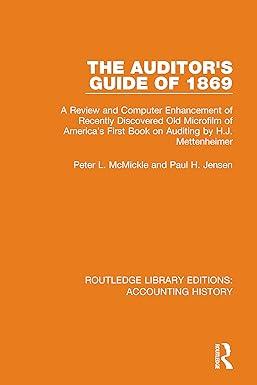Question
Intangible assets include Question 1 options: a) property, plant, and equipment. b) natural resources, such as mineral deposits and oil and gas reserves. c) assets
Intangible assets include
Question 1 options:
|
|
| ||
|
|
| ||
|
|
| ||
|
|
|
Question 2 (1 point)
Saved
A company purchased land for $70,000 cash. $7,000 was spent for demolishing an old building on the land before construction of a new building could start Under the cost principle, the cost of land would be recorded at:
Question 2 options:
|
|
| ||
|
|
| ||
|
|
| ||
|
|
|
Question 3 (1 point)
Saved
The balance in the Accumulated Amortization account represents the
Question 3 options:
|
|
| ||
|
|
| ||
|
|
| ||
|
|
|
Question 4 (1 point)
The net book value of an asset is equal to the
Question 4 options:
|
| asset's market value less its historical cost. |
|
| asset's cost less amortization expense. |
|
| replacement cost of the asset. |
|
| asset's cost less accumulated amortization. |
Question 5 (1 point)
In calculating amortization, residual value is
Question 5 options:
|
|
| ||
|
|
| ||
|
|
| ||
|
|
|
Question 6 (1 point)
The declining-balance method of amortization produces
Question 6 options:
|
| a decreasing amortization expense each period. |
|
| an increasing amortization expense each period. |
|
| a declining percentage rate each period. |
|
| a constant amount of amortization expense each period. |
Question 7 (1 point)
A company purchased factory equipment for $100,000. It is estimated that the equipment will have a $10,000 residual value at the end of its estimated 5-year useful life. If the company uses the double declining-balance method of amortization, the amount of annual amortization recorded for the second year after purchase would be
Question 7 options:
|
|
| ||
|
|
| ||
|
|
| ||
|
|
|
Question 8 (1 point)
A factory machine was purchased for $20,000 on January 1, 2015. It was estimated that it would have a $4,000 residual value at the end of its 5-year useful life. It was also estimated that the machine would be run 40,000 hours in the 5 years. If the actual number of machine hours run in 2015 was 4,000 hours and the company uses the units-of-activity method of amortization, the amount of amortization expense for 2015 would be
Question 8 options:
|
|
| ||
|
|
| ||
|
|
| ||
|
|
|
Question (1 point)
Which of the following methods of calculating amortization is production based?
Question options:
|
| Straight-line |
|
| Declining-balance |
|
| Units-of-activity |
|
| None of these |
Management should select the amortization method that
Question options:
|
| is easiest to apply. |
|
| best measures the capital asset's market value over its useful life. |
|
| best measures the capital asset's contribution to revenue over its useful life. |
|
| has been used most often in the past by the company. |
These are all one question.
Step by Step Solution
There are 3 Steps involved in it
Step: 1

Get Instant Access to Expert-Tailored Solutions
See step-by-step solutions with expert insights and AI powered tools for academic success
Step: 2

Step: 3

Ace Your Homework with AI
Get the answers you need in no time with our AI-driven, step-by-step assistance
Get Started


